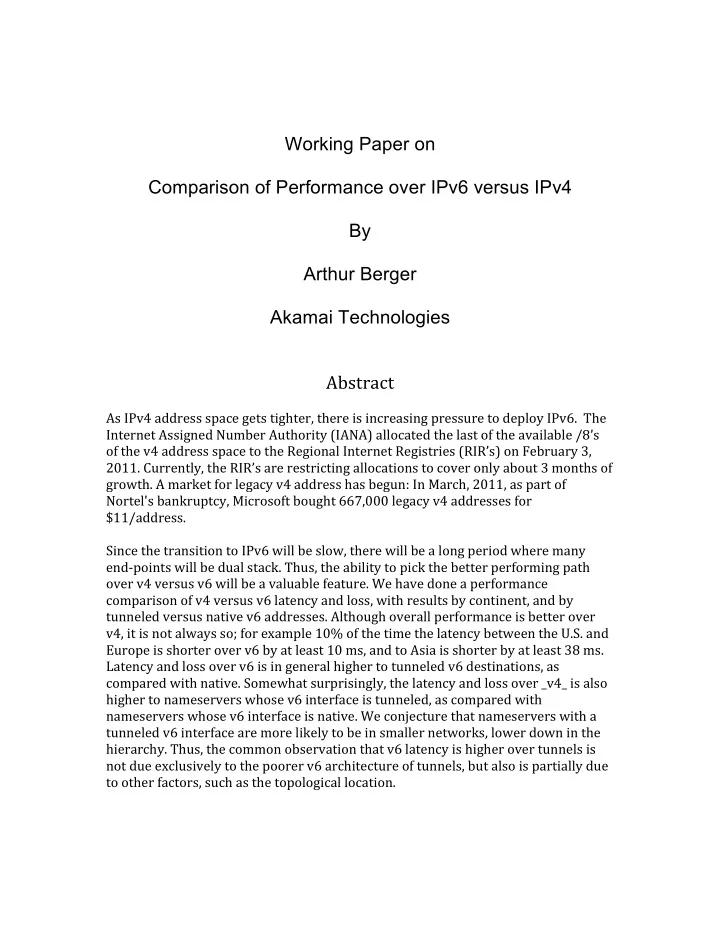

Working Paper on Comparison of Performance over IPv6 versus IPv4 By Arthur Berger Akamai Technologies Abstract As IPv4 address space gets tighter, there is increasing pressure to deploy IPv6. The Internet Assigned Number Authority (IANA) allocated the last of the available /8’s of the v4 address space to the Regional Internet Registries (RIR’s) on February 3, 2011. Currently, the RIR’s are restricting allocations to cover only about 3 months of growth. A market for legacy v4 address has begun: In March, 2011, as part of Nortel's bankruptcy, Microsoft bought 667,000 legacy v4 addresses for $11/address. Since the transition to IPv6 will be slow, there will be a long period where many end‐points will be dual stack. Thus, the ability to pick the better performing path over v4 versus v6 will be a valuable feature. We have done a performance comparison of v4 versus v6 latency and loss, with results by continent, and by tunneled versus native v6 addresses. Although overall performance is better over v4, it is not always so; for example 10% of the time the latency between the U.S. and Europe is shorter over v6 by at least 10 ms, and to Asia is shorter by at least 38 ms. Latency and loss over v6 is in general higher to tunneled v6 destinations, as compared with native. Somewhat surprisingly, the latency and loss over _v4_ is also higher to nameservers whose v6 interface is tunneled, as compared with nameservers whose v6 interface is native. We conjecture that nameservers with a tunneled v6 interface are more likely to be in smaller networks, lower down in the hierarchy. Thus, the common observation that v6 latency is higher over tunnels is not due exclusively to the poorer v6 architecture of tunnels, but also is partially due to other factors, such as the topological location.
Table of Contents 1 Dataset ....................................................................................................................................................3 2 Summary Stats by Geo Region......................................................................................................3 3 Comparison of V6 and V4 Latency: Distributions...............................................................6 4 Comparison Across Time................................................................................................................9 4.1 April to December, 2010.........................................................................................................9 4.2 July 12 through 14, 2010..................................................................................................... 15 5 Related Work..................................................................................................................................... 21 6 References.......................................................................................................................................... 22 7 Appendix A. Distribution of Packet Loss............................................................................... 23 8 Appendix B. Additional Latency Distributions.................................................................. 27 Arthur Berger Page 2 of 30 March 29, 2011
Performance Comparison of v6 versus v4 1 Dataset Pings were sent to 6,864 globally distributed dual‐stack nameservers from three locations in the U.S.: Dallas, TX; San Jose, CA; and Reston, VA. The present report considers measurements for the period from April 12, 2010 through December 19, 2010. For this period, we have 44 million measurements on 9,223 distinct time epochs. There are time periods where no measurements were collected, most notably April 24 to 25, June 25 to July 1, August 11 to 24, and October 27 to November 8. For 2,085 of the 6,864 nameservers, the IPv6 interface is a 6to4 tunnel (address 2002::/16) and 33 are a Teredo tunnel (address 2001:0::/32), where these are the two most popular tunneling methodologies currently in use. We have partitioned some of the results below into "tunneled" and "native" based on the IPv6 address of the nameservers. Caution: it is possible that a path to a "native" nameserver does contain a tunnel. 2 Summary Stats by Geo Region In terms of the summary statistics, Table 1 shows the summary statistics of median, mean, and ninety‐fifth percentile of latency over v4 and over v6, conditioned on the geographic region of the nameserver and whether the v6 interface of the nameserver is native, tunneled, or either. A first observation is that in terms of these summary statistics, the latency is less over v4 than v6. For example, for destinations in the North America, the mean latency is 55 ms over v4 but substantially higher, 101 ms, over v6. A second observation is that, except for South America, the latency is higher to destinations where the v6 interface is tunneled, as opposed to native, and this pertains for both the v6 and v4 path. For example, for destinations in Asia where the v6 interface is native, the mean latency over v6 was 212 ms. For v6 interfaces that are tunneled, the mean latency over v6 was significantly higher at 317 ms. And also over v4, the mean latency is again higher to destinations where the v6 interface is tunneled, 205 ms versus 245 ms. That the latency over v6 is higher to tunneled destinations is consistent with common expectations; however, it is somewhat a surprise that the latency over v4 is also higher. How could the v6 interface affect the latency over the v4 path? Admittedly the set of nameservers are distinct; that is, we are comparing v4 latency to one set of destinations, those whose v6 interface is tunneled, with the v4 latency to another set, albeit in the same geographic region. However, this alone does not imply any intrinsic bias and thus does not explain why the latency (in terms of the Arthur Berger Page 3 of 30 March 29, 2011
Recommend
More recommend